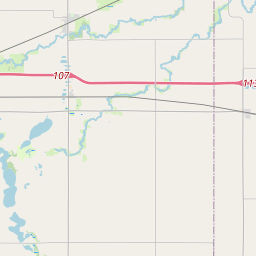A Golden Dedication for I-90
Historical marker location:
Blue Earth, Minnesota
( Marker can be reached from Interstate 90 at milepost 118,, 0.6 miles west of U.S. 169, on the right when traveling east.)







© OpenStreetMap contributors
Loading...
Searching for other points of interest within 10 miles of this location.Minnesota was named after the Minnesota River, which got its name from the Dakota Sioux word "Mnisota," meaning "sky-tinted water."
About Faribault County
Faribault County Timeline
Faribault County, located in southern Minnesota, has a rich history that dates back centuries. The region was originally home to indigenous peoples, including the Dakota Sioux and Ojibwe tribes, who relied on the area's abundant natural resources for their livelihoods.
European settlement in the area began in the mid-19th century, with pioneers attracted to the fertile land for farming. In 1855, Faribault County was officially established and named after Jean-Baptiste Faribault, a prominent fur trader and settler in the region. The county seat was initially located in Blue Earth City, but was later moved to the city of Blue Earth.
Throughout its history, agriculture has been the backbone of Faribault County's economy. The region's rich soil and favorable climate made it well-suited for farming, particularly corn and soybean production. As the agricultural industry grew, infrastructure development followed, including the construction of railroads that helped transport goods efficiently.
Over the years, Faribault County has also experienced significant social and cultural changes. Immigrants from Germany, Scandinavia, and other European countries settled in the area, bringing their distinct traditions and contributing to the county's diverse heritage. Today, Faribault County continues to thrive as a vibrant community, with a mix of agriculture, manufacturing, and service industries supporting the local economy.
European settlement in the area began in the mid-19th century, with pioneers attracted to the fertile land for farming. In 1855, Faribault County was officially established and named after Jean-Baptiste Faribault, a prominent fur trader and settler in the region. The county seat was initially located in Blue Earth City, but was later moved to the city of Blue Earth.
Throughout its history, agriculture has been the backbone of Faribault County's economy. The region's rich soil and favorable climate made it well-suited for farming, particularly corn and soybean production. As the agricultural industry grew, infrastructure development followed, including the construction of railroads that helped transport goods efficiently.
Over the years, Faribault County has also experienced significant social and cultural changes. Immigrants from Germany, Scandinavia, and other European countries settled in the area, bringing their distinct traditions and contributing to the county's diverse heritage. Today, Faribault County continues to thrive as a vibrant community, with a mix of agriculture, manufacturing, and service industries supporting the local economy.
Faribault County Timeline
This timeline provides a glimpse into the major events and milestones that have shaped the history of Faribault County, Minnesota.
- 1855 - Faribault County is established by the Minnesota Territorial Legislature.
- 1856 - The first settlers, Harry McCauley and Charles W. Thompson, arrive in what would become Faribault County.
- 1857 - The county's first post office is established in Delavan.
- 1858 - The county seat is designated as Blue Earth, named after the nearby Blue Earth River.
- 1859 - Faribault County's first courthouse is constructed in Blue Earth.
- 1862 - The Dakota War of 1862 breaks out, affecting the settlers in Faribault County.
- 1865 - The first railroad, the Winona and St. Peter Railroad, reaches Faribault County.
- 1871 - The current Faribault County Courthouse is completed in Blue Earth.
- 1899 - The city of Wells is incorporated in Faribault County.
- 1918 - The influenza pandemic, commonly known as the Spanish flu, hits Faribault County.
- 1935 - The Minnesota State Hospital for Crippled Children, now known as the Minnesota State Academy for the Deaf, is established in Faribault County.
- 1976 - Faribault County celebrates the United States Bicentennial with various events and activities.
- 1998 - A tornado causes significant damage in the city of Wells and other parts of Faribault County.
- 2010 - The population of Faribault County is approximately 14,553 people.